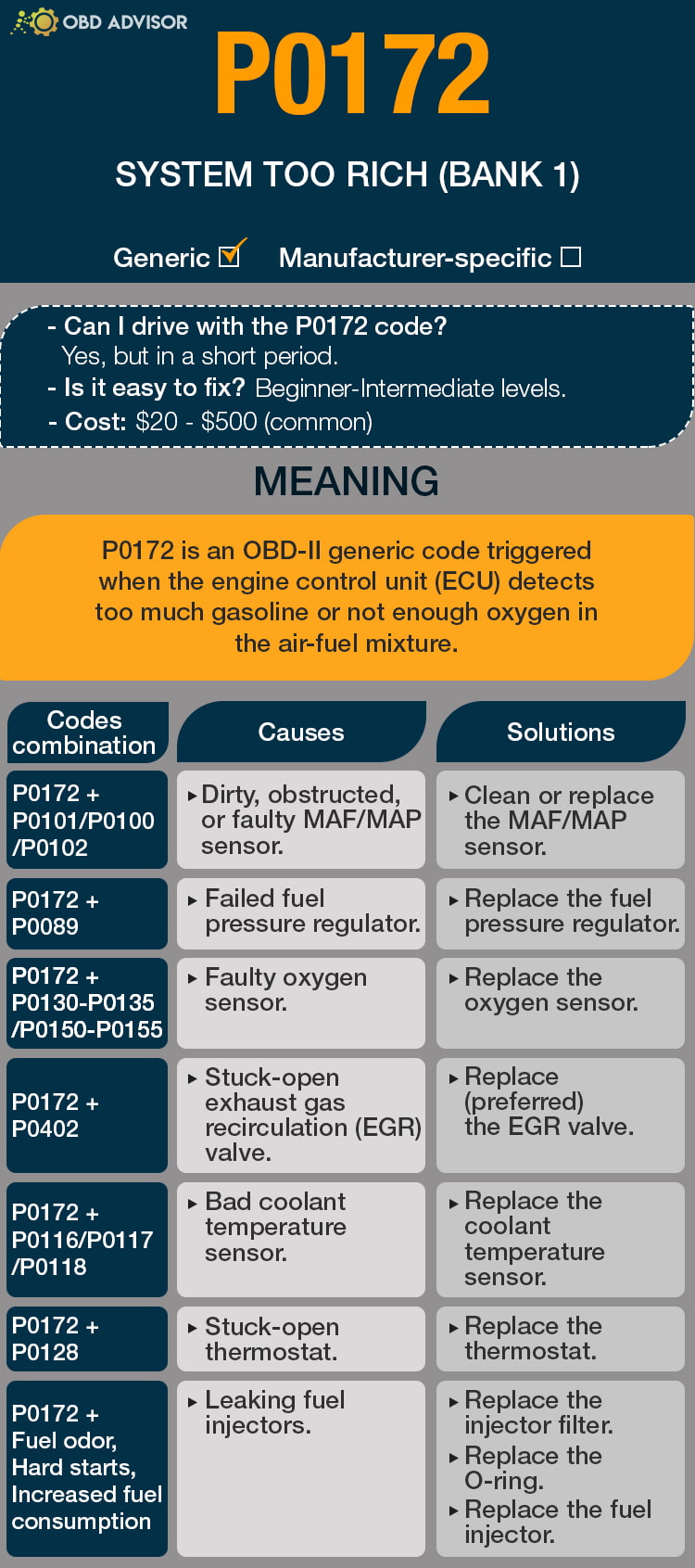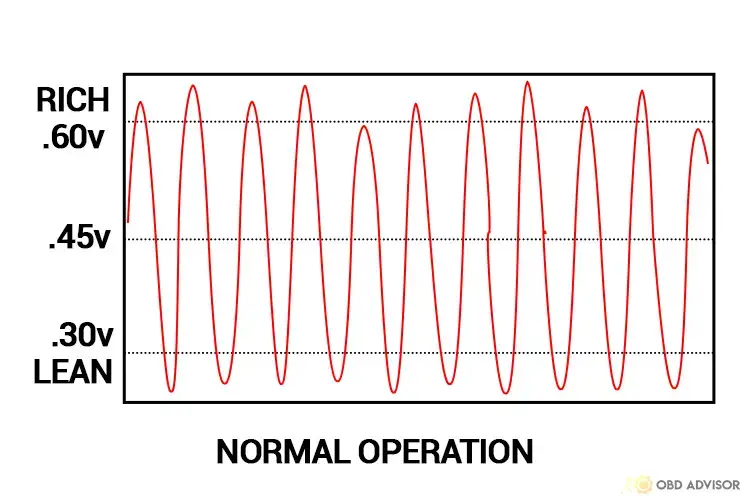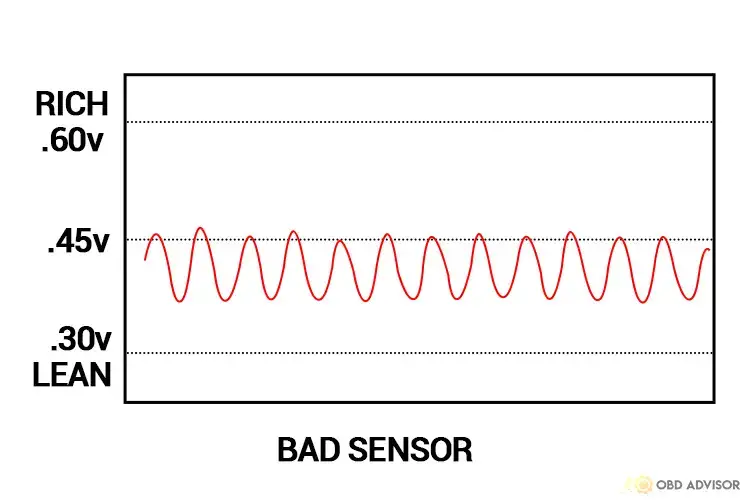P0172: System Too Rich (Bank 1)
Was the P0172 code activated on your scan tool? Do you wonder whether it is dangerous to keep driving?
Read on to have a first evaluation of your situation!
- P0172 Definition: System Too Rich (Bank 1)
- Code Type: Generic – P0172 indicates the same problem whether you’re having a Chevy, Honda, or Toyota, etc.
- Can I drive with the P0172 code? Yes, but you should drive for a short period. Extending driving will cause more severe damage to your engine.
- Easy to fix? Beginner-Intermediate level.
- Cost: $30 – $280 (common)
Now, you know this code is not that dangerous.
If you don’t want to waste your money, let’s dive into 7 causes that might trigger the P0172 code and the corresponding solutions.
What Does The P0172 Code Mean?
P0172 is an OBD-II generic code triggered when the engine control unit (ECU) detects too much gasoline and not enough oxygen in the air-fuel mixture.
Further Explanation
The ECU monitors the engine’s air-fuel ratio through mass airflow sensor (MAF), oxygen sensors, and manifold absolute pressure (MAP).
The ideal air-fuel mixture (air-fuel ratio) is always following the rate of 14.7:1; 14.7 grams of air are required for every 1 gram of fuel. This specific ratio was chosen because of its highest power output but lowest fuel consumption rate.
When the air-fuel ratio goes below 14.7, the amount of fuel in the combustion chamber is much more than the oxygen.
This is called a “rich” mixture, and then the ECU triggers the P0172 code.

P0172 Causes Identification: Quick View
When your scanner tool displays the P0172 code, sometimes the screen will show another code following P0172.
Here is a detailed table helping you identify which one is the culprit and find out the solutions immediately.
| Codes Combination | Causes | Solutions |
|---|---|---|
| P0172 + P0101 /P0100/P0102 | Dirty, obstructed, or faulty MAF/MAP sensor. | Clean or replace the MAF/MAP sensor. |
| P0172 + P0089 | Failed fuel pressure regulator. | Replace the fuel pressure regulator. |
| P0172 + P0130-P0135 | Faulty oxygen sensor. | Replace the oxygen sensor. |
| P0172 + P0402 | Stuck-open exhaust gas recirculation (EGR) valve. | Replace (preferred) the EGR valve. |
| P0172 + P0116/P0117/P0118 | Bad coolant temperature sensor. | Replace the coolant temperature sensor. |
| P0172 + P0128 | Stuck-open thermostat. | Replace the thermostat. |
| P0172 + Fuel odor, Hard starts, Increased fuel consumption | Leaking fuel injectors. | Replace the injector filter. Replace the O-ring. Replace the fuel injector. |
Note: The causes for each code combination are the most common ones. There can be some uncommon issues hidden under those codes.
P0172: Causes, Symptoms, And How To Fix
Cause #1: Faulty MAF/MAP Sensor
The mass airflow (MAF) and manifold absolute pressure (MAP) sensor are essential to your car’s electronic fuel injection system.
Their function is to help the PCM determine the required fuel delivery for a perfect rate of 14.7:1.
You can find them near the engine’s intake manifold.
Over time, the MAF/MAP sensor can be contaminated for many reasons, such as dirt, air, and debris in the sensor.
That’s why they failed, leading to overstating the number of air flowing into the engine.
Hence, drivers should pay attention to any of the following symptoms in their vehicle’s performance:
- P0172 and P0101/P0100/P0102 code activated.
- Check engine light on.
- Black exhaust smoke.
- Rough idle.
- Poor fuel economy.
- Poor acceleration.
You can easily fix the P0172 code by cleaning the dirty MAF/MAP sensor or replacing it if the MAF/MAP sensor is faulty.
Cause #2: Faulty Fuel Pressure Regulator
A fuel pressure regulator regulates the fuel pressure (35-65 psi) going to the fuel injectors.
Suitable fuel pressure (air to fuel ratio) helps your vehicle run with maximized power and fuel economy. If the fuel regulator goes wrong, the fuel pressure is too high, resulting in a rich air-fuel ratio.
A ruptured diaphragm inside the regulator and a stuck closed regulator are two reasons causing a rich running condition.
If you notice these symptoms, your vehicle may have a bad fuel pressure regulator:
- A combination of P0172 and P0089 codes appeared.
- Poor engine performance.
- A fuel leak in the regulator’s vacuum line.
- Black smoke.
- Soot on spark plugs.
Replacing the fuel pressure regulator with a new one will solve this problem.
Cause #3: Faulty Oxygen Sensor
An oxygen sensor (upstream) is a device used to help the engine keep a specific air-fuel ratio that balances power, fuel economy, and emissions.
When the O2 sensor is defective, it might detect the wrong amount of air and send it back to the ECU, making the air-fuel ratio not follow the standard rate.
If you don’t want more damage to your car, take a look at these signs:
- P0172 and faulty O2 sensor codes (P0130-P0135) appeared.
- Check engine light on.
- Poor fuel efficiency.
- Smell and black smoke from the exhaust.
- “Lazy” O2 sensor voltage chart.
“Lazy” O2 Sensor Voltage Chart


Replacing a faulty oxygen sensor is an effective way to fix the P0172 code if it is the problem.
Cause #4: Stuck-Open EGR Valve
Exhaust Gas Recirculation (EGR) is a system used for reducing automotive nitrogen oxide (NOx) emissions.
It works by taking a small quantity of the exhaust gas back to the engine’s combustion chambers through the intake manifold.
After a long time, carbon deposits build-up inside the EGR valve, sticking it open.
The endless exhaust gas takes the air’s place, making the amount of air decrease dramatically. Consequently, the air-fuel ratio is not balanced anymore.
Stuck-open EGR will bring you a lot of bad situations, and you should look for these signs to clean or replace the EGR valve as soon as possible:
- P0172 and P0402 code triggered.
- Poor performance.
- Rough idle.
- Increased fuel consumption.
- Smell of exhaust gas.
- Engine knock.
- More emissions.
With a stuck-open EGR valve, it is recommended to replace it as the EGR valve is not too pricey.
If you have a low budget, try to clean the build-up inside with this video.
Cause #5: Bad Coolant Temperature Sensor
As evident from its name, an engine coolant temperature sensor (ECT) measures the engine coolant’s temperature.
An inaccurate coolant temperature can cause a rich condition because they will report that the engine is still cold, which will cause the PCM to keep the mixture rich long after the engine is at proper operating temperature.
Here are some significant symptoms of a faulty coolant temperature sensor:
- P0172 and P0116/P0117/P0118 codes activated.
- Check engine light on.
- Overheated engine.
- Poor fuel efficiency.
- Poor engine performance.
- Black smoke from the exhaust pipe.
In addition to these symptoms, you can take a small test to compare the coolant temperature with a thermal gun and the ECT’s temperature in the Live Data function. If the number on the thermal gun is different from the one on the scan tool (>190ºF), maybe your ECT sensor is broken down.
A coolant temperature sensor is not too expensive, you can erase this code from your car by replacing the ECT sensor.
Cause #6: Stuck-Open Thermostat


The engine thermostat is a valve that can open and close to let the coolant flow into the radiator, lowering the engine’s temperature.
A stuck-open thermostat can make your engine still cold and take more time to warm up. Therefore, your car’s engine may not be likely to reach proper operating temperature and need a richer fuel mixture, leading to more fuel than air.
To avoid any further damage, you should notice these obvious signs:
- A combination of P0172 and P0128 pops up.
- Long warm-up time.
- Lack of heat.
- Poor gas mileage.
It’s not easy to unstick the stuck-open thermostat as it seems. I suggest you should replace the thermostat with a new one since it’s inexpensive.
Cause #7: Leaking Fuel Injectors
Fuel injectors spray the fuel as mist into a car’s engine through a small nozzle.
Leaking fuel injectors appeared in older cars with high mileage. A fuel injector can leak due to two primary causes:
- The body of the injector
- The O-ring
When the fuel injector leaks, it will spray excess fuel in liquid form, not mist. Keeping the fuel injector leaking constantly will create a rich air-fuel mixture.
Be careful with these symptoms if they appear on your car:
- Hard starts.
- Fuel odor.
- Hesitation or shaking while idling.
- Increased fuel consumption.
- Increased exhaust.
- Thinning oil.
- Hydrolocking.
There are three ways you can use to fix the leaking fuel injectors, you can replace the injector filter, the injector O-ring, or the fuel injector itself.
How Much Does It Cost To Fix The Code P0172?
Repair and replacement costs to fix the P0172 code can vary a lot if you choose to fix it yourself or go to a mechanic shop.
For DIYers, it will cost you around $300 for the most expensive part.
If you can’t handle it on your own, you have to pay from $70-$500 for a mechanic.
The Estimated Repair Cost Of P0172
| Solutions | Cost |
|---|---|
| Clean MAF/MAP sensor | – DIY: $15 – Repair shop: $50 – $100 |
| Replace MAF/MAP sensor | – DIY: $30 – $200 – Repair shop: $80 – $280 |
| Replace the fuel pressure regulator | – DIY: $50 – $200 – Repair shop: $150 – $350 |
| Replace the injector filter | – DIY: $15 – $20 – Repair shop: $200 – $300 |
| Replace the injector O-ring | – DIY: $1 – $20 – Repair shop: $150 – $400 |
| Replace the fuel injector | – DIY: $70 – $280 – Repair shop: $200 – $500 |
| Replace (preferred) the EGR valve | – DIY: $190 – $270 – Repair shop: $250 – $350 |
| Replace the ECT sensor | – DIY: $20 – $80 – Repair shop: $70 – $330 |
| Replace the thermostat | – DIY: $20 – $80 – Repair shop: $140 – $300 |
| Replace the oxygen sensor | – DIY: $20 – $130 – Repair shop: $70 – $250 |
Note: The data in this table is collected in May 2022. The actual price depends on many factors, such as your car’s make and year, mechanic’s rate, etc.
You Ask, I Answer
Although the P0172 code is not that severe, it will bring you a lot of troubles, such as poor fuel economy, hard starts, and poor engine performance.
I hope this article will help you save your budget from visiting the mechanic.
Any other questions about P0172, don’t hesitate to leave a comment below, I’ll answer them all.
If you have had the same issue and fixed it before, share your story with us.
See ya!
Read more: The 9 Best OBD2 Scanners for 2024: The Only Review You Need
